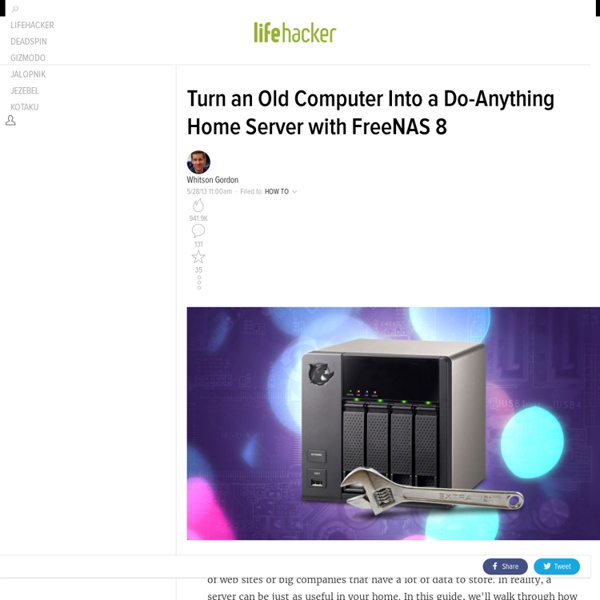



KillerStartups - Where Internet Entrepreneurs Are The Stars OverAPI.com | Collecting all the cheat sheets Set up a VPN on your Zentyal small business server Zentyal Community Edition small business server is a great and free solution for any company that needs functionality similar to Windows Small Business Server, but does not have the budget for Microsoft's take on the multi-function server. (There are other editions of Zentyal that are not free.) Zentyal Community Edition offers plenty of features to meet your needs, which include: VPN serverFirewall and routing DHCP server DNS server NTP server Email server (including webmail) Certificate Authority Web server Workgroup (including Windows Active Directory syncing) XMPP server I'll walk through the process of setting up a VPN server on your Zentyal Community Edition small business server. The VPN server on Zentyal is an OpenVPN PPTP server, which benefits from: Public key authentication SSL-based encryption Clients available for Windows, Mac, and Linux Allows use of network applications transparently Let's set this VPN server up. Create a Certificate Authority and certificates 1. 2. 3. 1. 2.
Word Cloud Generator How the Word Cloud Generator Works The layout algorithm for positioning words without overlap is available on GitHub under an open source license as d3-cloud. Note that this is the only the layout algorithm and any code for converting text into words and rendering the final output requires additional development. As word placement can be quite slow for more than a few hundred words, the layout algorithm can be run asynchronously, with a configurable time step size. This makes it possible to animate words as they are placed without stuttering. It is recommended to always use a time step even without animations as it prevents the browser’s event loop from blocking while placing the words.
Language-Learning Software and Online Courses | Transparent Language Article: The Top 100 Indie Games Here's a list of 100 indie games that I've enjoyed. This list includes freeware games, shareware games, japanese indie import games, mods, and works in progress (WIP). It does not include browser games. I've tried to spread different genres more evenly around in the list so take the order as more of a general idea of how they rank than an absolute win/lose situation. For old Dos games, I suggest using Dos Box. The List! #100 Cosmic Invaders Direct Link (Freeware) Tower Defense meets Space Invaders. #99 Typestriker XE (Freeware) An odd attempt to mix Shmups with a typing tutor. #98 Red Ace Squadron Pro (Shareware) WWI "lite" flight sim with multiplayer capabilities. #97 Harpooned (Freeware) Shmup with a social conscience that wisely uses satire instead of preaching. #96 Progress Quest (Freeware) Fuck MMORPGs. #95 Space Hulk (Freeware) A computer adaptation of the Space Hulk board game. #94 Star Monkey (Shareware) #93 Juno Nemesis Remix (Shareware) #92 Ancient Domains of Mystery (Freeware)
Small Office/Home Networking Howto, Part 1: Setting up a LAN Setting up a LAN (Local Area Network) by James R. Williams Zavada, March 2002 Table of Contents Disclaimer: This information is provided in the hopes that you will find it useful and instructive. Any and all trademarks mentioned in this text are property of their respective owners. Introduction: The goal of this Howto is to provide the basic information needed to create a small office/home network using ethernet. It is also important to keep in mind that networking, although possible for mere mortals, can be fraught with frustration and problems. Finally, this part of the Howto (Part 1) will only show you how to set up a basic network. Prerequisites: Hardware Requirements In order to set up a network, you will need an ethernet hub, an ethernet adapter for each computer you want to add to the network, and cables. Ethernet Hub As far as hubs go, any brand should work. Adapter Cards You'll need an adapter card for each computer you want to connect to your network. Cables Software Requirements
Big Data: why is metadata more personal than our fingerprints A l’occasion du colloque « la politique des données personnelles : Big Data ou contrôle individuel « organisé par l’Institut des systèmes complexes et l’Ecole normale supérieure de Lyon qui se tenait le 21 novembre dernier, Yves-Alexandre de Montjoye (@yvesalexandre) était venu présenter ses travaux, et à travers lui, ceux du MediaLab sur ce sujet (Cf. « D’autres outils et règles pour mieux contrôler les données » ). Yves-Alexandre de Montjoye est doctorant au MIT. Il travaille au laboratoire de dynamique humaine du Media Lab, aux côtés de Sandy Pentland, dont nous avons plusieurs fois fait part des travaux. Nos données de déplacements sont encore plus personnelles que nos empreintes digitales Faire correspondre des empreintes digitales n’est pas si simple, rappelle Yves-Alexandre de Montjoye. Image : illustration de l’unicité de nos parcours repérés via des antennes mobiles. Et Yves-Alexandre de nous inviter à retrouver un de ses collègues du Media Lab. Hubert Guillaud